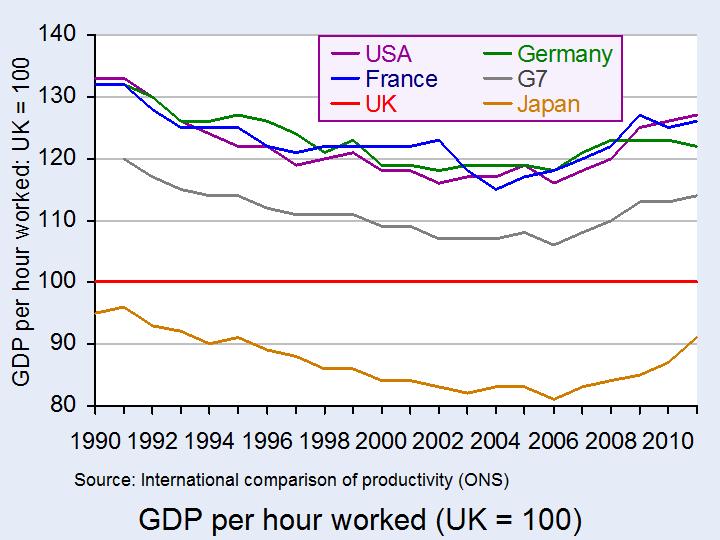 Much has been written on Margaret Thatcher following her death at the age of 87 on April 8. But getting a calm assessment of both her time in office and her legacy is not easy. And it’s clear why: she created both stronger loyalty and stronger opposition than any other UK Prime Minister.
Much has been written on Margaret Thatcher following her death at the age of 87 on April 8. But getting a calm assessment of both her time in office and her legacy is not easy. And it’s clear why: she created both stronger loyalty and stronger opposition than any other UK Prime Minister.
As economists, however, we should try to be as dispassionate as possible in assessing the effects of policies. There is always a normative question of the relative desirability of different economic outcomes – and you will have your own views on the relative importance of objectives such as economic growth, greater equality and greater social cohesion – but to determine cause and effect, or at least correlation, requires a careful examination of the evidence. Also, drawing lessons for future policy requires a careful modelling of the economy and the effects of changing economic variables.
The following articles have been selected from the hundreds that have appeared in the press in the past few days. Whilst they cannot be claimed to be totally ‘objective’, taken together they give a good overview of her economic policies and her economic legacy.
You may well have been surprised by the amount of coverage of her death and at the fervour of her supporters and critics. But this bears witness to the huge effect she had on both the political scene and on the UK economy – for good or bad.
Articles
Margaret Thatcher’s timeline: From Grantham to the House of Lords, via Arthur Scargill and the Falklands War Independent (8/4/13)
Overhauls Are Still Felt, Debated Decades Later Wall Street Journal, Charles Forelle (9/4/13)
Margaret Thatcher’s Four Ages of Monetary Policy EconoMonitor, David Smith (10/4/13)
How Mrs Thatcher smashed the Keynesian consensus The Economist (9/4/13)
Margaret Thatcher: The economy now and then BBC News, Stephanie Flanders (10/4/13)
Did Margaret Thatcher transform Britain’s economy for better or worse? The Guardian, Larry Elliott (8/4/13)
A look back at Margaret Thatcher’s economic record Washington Post, Dylan Matthews (8/4/13)
Margaret Thatcher’s legacy for business and economics—the world weighs in Quartz, Gwynn Guilford (8/4/13)
Data
Economic Data freely available online The Economics Network, see especially sites 1, 2, 3, 6 and 9
Questions
- Summarise the macroeconomic policies followed by the Thatcher government from 1979 to 1990.
- Chart economic growth, unemployment and inflation over Margaret Thatcher’s time in office. How does the performance of each of these indicators compare with the period from 1990 to 2007 and from 2008 to the present day?
- What is meant by ‘monetarism’? Did the Thatcher government follow pure monetarist policies?
- What is meant by the ‘Big Bang’ as applied to the financial sector in 1986? Assess the long-term consequences of the Big Bang.
- What elements of ‘Thatcherism’ were retained by the Labour government from 1997 to 2010?
- To what extent can the current Coalition government be described as ‘Thatcherite’?
 The UK economy is suffering from a lack of aggregate demand. Low spending in real terms is preventing the economy from growing. A simple solution would seem to be to stimulate aggregate demand through fiscal policy, backed up by even looser monetary policy. But this is easier said than done and could result in undesirable consequences in the medium term.
The UK economy is suffering from a lack of aggregate demand. Low spending in real terms is preventing the economy from growing. A simple solution would seem to be to stimulate aggregate demand through fiscal policy, backed up by even looser monetary policy. But this is easier said than done and could result in undesirable consequences in the medium term.
If increased borrowing were to be used to fund increased government expenditure and/or cuts in taxes, would any resulting growth be sufficient in the medium term to reduce the public-sector deficit below the initial level through automatic fiscal stabilisers? And would the growth be sustainable? The answer to this second question depends on what happens to the supply side of the economy. Would there be an increase in aggregate supply to match the increase in aggregate demand?
 This second question has led many economists to argue that we need to see a rebalancing of the economy. What is needed is an increase in investment and exports, rather than an increase in just consumer expenditure funded by private borrowing and government current expenditure funded by public borrowing.
This second question has led many economists to argue that we need to see a rebalancing of the economy. What is needed is an increase in investment and exports, rather than an increase in just consumer expenditure funded by private borrowing and government current expenditure funded by public borrowing.
But how will exports and investment be stimulated? As far as exports are concerned, it was hoped that the depreciation of the pound since 2008 would give UK exporters a competitive advantage. Also domestic producers would gain a competitive advantage in the UK from imports becoming more expensive. But the current account deficit has actually deteriorated. According to the EU’s AMECO database, in 2008 the current account deficit was 1% of GDP; in 2012 it was 3.7%. It would seem that UK producers are not taking sufficient advantage of the pound’s depreciation, whether for exports or import substitutes.
 As far as investment is concerned, there are two major problems. The first is the ability to invest. This depends on financing and things such as available land and planning regulations. The second is the confidence to invest. With not little or no growth in consumer demand, there is little opportunity for the accelerator to work. And with forecasts of sluggish growth and austerity measures continuing for some years, there is little confidence in a resurgence in consumer demand in the future. (Click here for a PowerPoint of the above chart. Note that the 2013 plots are based on AMECO forecasts.)
As far as investment is concerned, there are two major problems. The first is the ability to invest. This depends on financing and things such as available land and planning regulations. The second is the confidence to invest. With not little or no growth in consumer demand, there is little opportunity for the accelerator to work. And with forecasts of sluggish growth and austerity measures continuing for some years, there is little confidence in a resurgence in consumer demand in the future. (Click here for a PowerPoint of the above chart. Note that the 2013 plots are based on AMECO forecasts.)
So hope of a rebalancing is faint at the current time. Hence the arguments for an increase in government capital expenditure that we looked at in the last blog post (The political dynamite of calm economic reflection). The problem and the options for government are considered in the following articles.
Articles
Budget 2013: Chancellor’s rebalancing act BBC News, Stephanie Flanders (11/3/13)
Why George Osborne is failing to rebalance the economy The Guardian, Larry Elliott (17/3/13)
Economy fails to ‘rebalance’ Financial Times, Sarah O’Connor (27/2/13)
Analysis – Long haul ahead for Britain’s struggling economy Reuters, William Schomberg (3/3/13)
Can banks be forced to lend more? BBC News, Robert Peston (12/3/13)
Budget 2013: What the commentators are saying BBC News (13/3/13)
Data
UK Trade, January 2013 (ONS) (12/3/13)
Business investment, Q4 2012 ONS (27/2/13)
Questions
- Draw a diagram to illustrate the effects of a successful policy to increase both aggregate demand and aggregate supply. What will determine the effect on the output gap?
- For what reasons has the UK’s current account deteriorated over the past few years while those of the USA and the eurozone have not?
- Using ONS data, find out what has happened to the UK’s balance of trade in (a) goods and (b) services over the past few years and explain your findings.
- Why are firms reluctant to invest at the moment? What policy measures could the government adopt to increase investment?
- With interest rates so low, why don’t consumers borrow and spend more, thereby aiding the recovery?
 In a carefully argued article in the New Statesman, the UK Business Secretary, Vince Cable, considers the slow recovery in the economy and whether additional measures should be adopted. He sums up the current state of the economy as follows:
In a carefully argued article in the New Statesman, the UK Business Secretary, Vince Cable, considers the slow recovery in the economy and whether additional measures should be adopted. He sums up the current state of the economy as follows:
The British economy is still operating at levels around or below those before the 2008 financial crisis and roughly 15 per cent below an albeit unsustainable pre-crisis trend. There was next to no growth during 2012 and the prospect for 2013 is of very modest recovery.
Unsurprisingly there is vigorous debate as to what has gone wrong. And also what has gone right; unemployment has fallen as a result of a million (net) new jobs in the private sector and there is vigorous growth of new enterprises. Optimistic official growth forecasts and prophets of mass unemployment have both been confounded.
He argues that supply-side policies involving “a major and sustained commitment to skills, innovation and infrastructure investment” are essential if more rapid long-term growth is to be achieved. This is relatively uncontroversial.
 But he also considers the claim that austerity has kept the economy from recovering and whether policies to tackle the negative output gap should be adopted, even if this means a short-term increase in government borrowing.
But he also considers the claim that austerity has kept the economy from recovering and whether policies to tackle the negative output gap should be adopted, even if this means a short-term increase in government borrowing.
But crude Keynesian policies of expanding aggregate demand are both difficult to implement and may not take into account the particular circumstance of the current extended recession – or depression – in the UK and in many eurozone countries. World aggregate demand, however, is not deficient. In fact it is expanding quite rapidly, and with the sterling exchange rate index some 20% lower than before the financial crisis, this should give plenty of opportunity for UK exporters.
Yet expanding UK aggregate demand is proving difficult to achieve. Consumers, worried about falling real wages and large debts accumulated in the years of expansion, are reluctant to increase consumption and take on more debts, despite low interest rates. In the light of dampened consumer demand, firms are reluctant to invest. This makes monetary policy particularly ineffective, especially when banks have become more risk averse and wish to hold higher reserves, and indeed are under pressure to do so.
 So what can be done? He argues that there is “some scope for more demand to boost output, particularly if the stimulus is targeted on supply bottlenecks such as infrastructure and skills.” In other words, he advocates policies that will simultaneously increase both aggregate demand and aggregate supply. Monetary policy, involving negative real interest rates and quantitative easing, has helped to prevent a larger fall in real aggregate demand and a deeper dive into recession, but the dampened demand for money and the desire by banks to build their reserves has meant a massive fall in the money multiplier. Perhaps monetary policy needs to be more aggressive still (see the blog post, Doves from above), but this may not be sufficient.
So what can be done? He argues that there is “some scope for more demand to boost output, particularly if the stimulus is targeted on supply bottlenecks such as infrastructure and skills.” In other words, he advocates policies that will simultaneously increase both aggregate demand and aggregate supply. Monetary policy, involving negative real interest rates and quantitative easing, has helped to prevent a larger fall in real aggregate demand and a deeper dive into recession, but the dampened demand for money and the desire by banks to build their reserves has meant a massive fall in the money multiplier. Perhaps monetary policy needs to be more aggressive still (see the blog post, Doves from above), but this may not be sufficient.
Which brings Dr Cable to the political dynamite! He advocates an increase in public investment on infrastructure (schools and colleges, hospitals, road and rail projects and housing, and considers whether this should be financed, not by switching government expenditure away from current spending, but by borrowing more.
Such a strategy does not undermine the central objective of reducing the structural deficit, and may assist it by reviving growth. It may complicate the secondary objective of reducing government debt relative to GDP because it entails more state borrowing; but in a weak economy, more public investment increases the numerator and the denominator.
 He raises the question of whether the balance of risks has changed: away from the risk of increased short-term borrowing causing a collapse of confidence to the risk of lack of growth causing a deterioration in public finances and this causing a fall in confidence. As we saw in the blog post Moody Blues, the lack of growth has already caused one ratings agency (Moody’s) to downgrade the UK’s credit rating. The other two major agencies, Standard & Poor’s and Fitch may well follow suit.
He raises the question of whether the balance of risks has changed: away from the risk of increased short-term borrowing causing a collapse of confidence to the risk of lack of growth causing a deterioration in public finances and this causing a fall in confidence. As we saw in the blog post Moody Blues, the lack of growth has already caused one ratings agency (Moody’s) to downgrade the UK’s credit rating. The other two major agencies, Standard & Poor’s and Fitch may well follow suit.
The day after Dr Cable’s article was published, David Cameron gave a speech saying that the government would stick to its plan of deficit reduction. Not surprisingly commentators interpreted this as a split in the Coalition. Carefully argued economics from Dr Cable it might have been, but political analysts have seen it as a hand grenade, as you will see from some of the articles below.
When the facts change, should I change my mind? New Statesman, Vince Cable (6/3/13)
Keynes would be on our side New Statesman, Vince Cable (12/1/11)
Exclusive: Vince Cable calls on Osborne to change direction New Statesman, George Eaton (67/3/13)
Vince Cable: Borrowing may not be as bad as slow growth BBC News (7/3/13)
Vince Cable makes direct challenge to Cameron over economic programme The Guardian, Nicholas Watt (7/3/13)
Vince Cable Says George Osborne Must Change Course And Borrow More To Revive Growth Huffington Post, Ned Simons (6/3/13)
David Cameron and Vince Cable at war over route to recovery Independent, Andrew Grice (6/3/13)
 Vince Cable: Borrowing may not be as bad as slow growth BBC News, James Landale (6/3/13)
Vince Cable: Borrowing may not be as bad as slow growth BBC News, James Landale (6/3/13)
David Cameron: We will hold firm on economy BBC News (7/3/13)
 David Cameron: We will hold firm on economy BBC News (7/3/13)
David Cameron: We will hold firm on economy BBC News (7/3/13)
 Clegg Backs Cable Over Controversial Economy Comments LBC Radio, Nick Clegg (7/3/13)
Clegg Backs Cable Over Controversial Economy Comments LBC Radio, Nick Clegg (7/3/13)
It’s plain what George Osborne needs to do – so just get on and do it The Telegraph, Jeremy Warner (6/3/13)
Vince Cable’s plan B: a “matter of judgement” BBC News, Stephanie Flanders (7/3/13)
George Osborne needs to turn on the spending taps The Guardian, Phillip Inman (12/3/13)
Questions
- Why has monetary policy proved ineffective in achieving a rapid recovery from recession?
- Distinguish between discretionary fiscal policy and automatic fiscal stabilisers.
- Why has the existence of automatic fiscal stabilisers meant that the public-sector deficit has been difficult to bring down?
- In what ways has the balance of risks in using discretionary fiscal policy changed over the past three years?
- In what ways is the depression of the late 2000s/early 2010s (a) similar to and (b) different from the Great Depression of the early 1930s?
- In what ways is the structure of public-sector debt in the UK different from that in many countries in the eurozone? Why does this give the government more scope for expansionary fiscal policy?
- Why does the Office of Budget Responsibility’s estimates of the tax and government expenditure multipliers suggest that “if fiscal policy is to work in a Keynesian manner, it needs to be targeted carefully, concentrating on capital projects”?
- Why did Keynes argue that monetary policy is ineffective at the zero bound (to use Dr Cable’s terminology)? Are we currently at the zero bound? If so what can be done?
- Has fiscal tightening more than offset loose monetary policy?
 Recent figures from the ONS suggest that the UK lags well behind its competitors in terms of labour productivity. In terms of output per hour worked, Germany produces 22% more than the UK, France produces 26% more, the USA produces 27% more, the Netherlands 31% more and Ireland 43% more. The first chart illustrates some of these figures.
Recent figures from the ONS suggest that the UK lags well behind its competitors in terms of labour productivity. In terms of output per hour worked, Germany produces 22% more than the UK, France produces 26% more, the USA produces 27% more, the Netherlands 31% more and Ireland 43% more. The first chart illustrates some of these figures.
(Click here for a PowerPoint of this chart.)
And in the past few years the problem has been getting worse. This is shown in the second chart. This, however, is a relatively recent phenomenon. Until 2006, the gap was narrowing, but since then it has widened. (Click here for a PowerPoint of the second chart.)
 What has caused this widening of the gap? Part of the problem is a historical lack of investment in the UK. Between 2005 and 2012, the UK invested on average 15.7% of GDP. The USA invested 16.5%, Germany 17.9% and France 20.1%. And part of the problem has been the cut back in private-sector investment in response to the recession (which has been deeper in the UK) and in public-sector investment as part of the government’s austerity measures.
What has caused this widening of the gap? Part of the problem is a historical lack of investment in the UK. Between 2005 and 2012, the UK invested on average 15.7% of GDP. The USA invested 16.5%, Germany 17.9% and France 20.1%. And part of the problem has been the cut back in private-sector investment in response to the recession (which has been deeper in the UK) and in public-sector investment as part of the government’s austerity measures.
Part of the problem has been lower levels of inward investment. Inward direct investment to the UK in 2011 was only 24 per cent of that in 2007. In France, Germany, Italy and the USA, the figures were 43, 50, 66 and 105 per cent respectively.
Part of the problem has been the size of the financial sector in the UK. This is considerably larger as a proportion of the economy than in most the UK’s major competitors. And it was this sector most hard hit by the crisis of 2007/8.
 With this poor productivity performance, you might expect unemployment to have soared. In fact, the UK has one of the lowest unemployment rates of the developed countries and in recent months it has been falling while other countries have seen their unemployment rates rise.
With this poor productivity performance, you might expect unemployment to have soared. In fact, the UK has one of the lowest unemployment rates of the developed countries and in recent months it has been falling while other countries have seen their unemployment rates rise.
In fact, low productivity and high employment are compatible. If people produce less than their counterparts abroad, then more people will be needed to produce the same level of output. The problem, of course, is that this only works if wages are kept down. Indeed, wages have fallen in real terms and now stand at the level of 10 years ago.
The problem of falling real wages is that this translates into a lack of demand – especially when people are trying to reduce their debts. Not only does this result in a lack of economic growth, it discourages firms from investing – and investment is one of the prime drivers of future productivity growth!
The following articles explore the problem of low productivity and its relationship with employment and with both short-term and long-term economic growth.
Articles
UK has widest productivity gap since 1993 City A.M., Ben Southwood (14/2/13)
Productivity ‘key to UK’s economic future’ SnowdropKCS (7/2/13)
Low wages and lack of investment – why UK’s productivity has slumped Wales Online, David Williamson (2/3/13)
Recovery in jobs gives a fillip before the news on growth Independent, Russell Lynch (23/1/13)
U.K. Triple-Dipping as Productivity Falls Slate, Matthew Yglesias (25/1/13)
UK productivity puzzle baffles economists BBC News, By Andrew Walker (18/10/12)
 Is low productivity a structural problem in the UK? BBC Today Programme, Bridget Rosewell and Andrew Sentance (4/1/13)
Is low productivity a structural problem in the UK? BBC Today Programme, Bridget Rosewell and Andrew Sentance (4/1/13)
We Need to Talk About the Middle Huffington Post, Stewart Wood (14/2/13)
UK Wages Slump to Lowest Level in a Decade – ONS International Business Times, Shane Croucher (13/2/13)
Britain’s low-wage economy serves as a bind on the country The Guardian, Philip Inman (13/2/13)
Real wages fall back to 2003 levels in UK The Guardian, Hilary Osborne (13/2/13)
Data
International Comparisons of Productivity – Final Estimates for 2011 ONS (13/2/13)
International Comparisons of Productivity, datasets ONS (13/2/13)
Changes in real earnings in the UK and London, 2002 to 2012 ONS (13/2/13)
Questions
- Which is a better measure of productivity – output per worker or output per hour worked? Why, do you think, does the USA produce 39% more per worker, but only 27% more per hour worked?
- What policies should the government adopt in order to encourage a growth in productivity?
- If productivity growth increased, what would be the likely effect on employment? Explain.
- Why has unemployment not risen in recent months?
 Japan’s general election on 16 December was won by the centre-right Liberal Democratic Party (LDP), led by Shinzo Abe. It gained a two-thirds majority in the lower house. It returns to power after losing to the Democratic Party in 2009. Previously it had been in office for most of the time since 1955.
Japan’s general election on 16 December was won by the centre-right Liberal Democratic Party (LDP), led by Shinzo Abe. It gained a two-thirds majority in the lower house. It returns to power after losing to the Democratic Party in 2009. Previously it had been in office for most of the time since 1955.
The LDP has promised to revive the flagging Japanese economy, which has been suffering from years of little or no growth and returned to recession last quarter. Economic confidence has been damaged by a dispute with China about the sovereignty over some small islands in the East China Sea. The economy, whose exports make up some 13% of GDP, has suffered from the global slowdown and a high yen. The yen has appreciated against the dollar by around 40% since 2007.
The economy has also suffered from the shutdown of all its nuclear reactors following the earthquake and tsunami last year. Nuclear power accounted for over 30% of the country’s electricity generation.
 Mr Abe promises to revive the economy through fiscal and monetary policies. He plans a fiscal stimulus package in early 2013, with increased government expenditure on infrastructure and other public-works. He also wants the Bank of Japan to increase its inflation target from 1% to 3% and to achieve this through various forms of monetary easing.
Mr Abe promises to revive the economy through fiscal and monetary policies. He plans a fiscal stimulus package in early 2013, with increased government expenditure on infrastructure and other public-works. He also wants the Bank of Japan to increase its inflation target from 1% to 3% and to achieve this through various forms of monetary easing.
The initial reactions of markets to the election result were favourable. The stock market rose and the yen fell.
However, as the following articles discuss, there are dangers associated with Mr Abe’s policies. The expansionary fiscal policy will lead to a rise in the country’s general-government debt, which, at some 240% of GDP, is by far the largest in the developed world. This could lead to a loss of confidence in Japanese debt and a fall in the price of bonds on the secondary markets and a rise in government borrowing costs. Also, a depreciation of the yen, while welcomed by exporters, would increase the price of imports, including food and raw materials.
Changing of guard in Japan as PM concedes vote CNN, Yoko Wakatsuki, Brian Walker, and Hilary Whiteman (17/12/12)
LDP Win Clears Pipes for Japan Fiscal Spigot Bloomberg Businessweek, Toru Fujioka (17/12/12)
Economic implications of Japan’s election Huffington Post (16/12/12)
Japan economy contracts again Taipei Times (11/12/12)
Japan elections: Shares rise and yen weakens on Abe win BBC News (17/12/12)
Shinzo Abe’s challenges in reviving Japan’s economy BBC News, Puneet Pal Singh (17/12/12)
Can Shinzo Abe Save Japan? Slate, Matthew Yglesias (30/11/12)
Deflation only natural when politicians refuse to fix oversupplied Japan Japan Times, Teruhiko Mano (17/12/12)
New Year messages from Japan BBC News, Stephanie Flanders (18/12/12)
Japan – Muddling On Or Growing Stronger? Seeking Alpha, Anthony Harrington (12/12/12)
Japanese government unveils £138bn stimulus package The Guardian (11/1/13)
Questions
- Using macroeconomic data from sources such as sites 6, 7 and 9 in the Economics Network’s Economic Data freely available online, describe Japan’s macroeconomic situation over the past 10 years.
- Why has the Japanese yen appreciated so much in recent years?
- What forms could monetary easing take in Japan?
- Why might it prove difficult to stimulate the Japanese economy through fiscal and monetary policies?
- What undesirable side-effects might result from expansionary fiscal and monetary policies?
- What structural weaknesses are there in the Japanese economy that have hindered economic growth? What policies might the new Japanese government pursue in tackling these structural weaknesses?
 Much has been written on Margaret Thatcher following her death at the age of 87 on April 8. But getting a calm assessment of both her time in office and her legacy is not easy. And it’s clear why: she created both stronger loyalty and stronger opposition than any other UK Prime Minister.
Much has been written on Margaret Thatcher following her death at the age of 87 on April 8. But getting a calm assessment of both her time in office and her legacy is not easy. And it’s clear why: she created both stronger loyalty and stronger opposition than any other UK Prime Minister.











